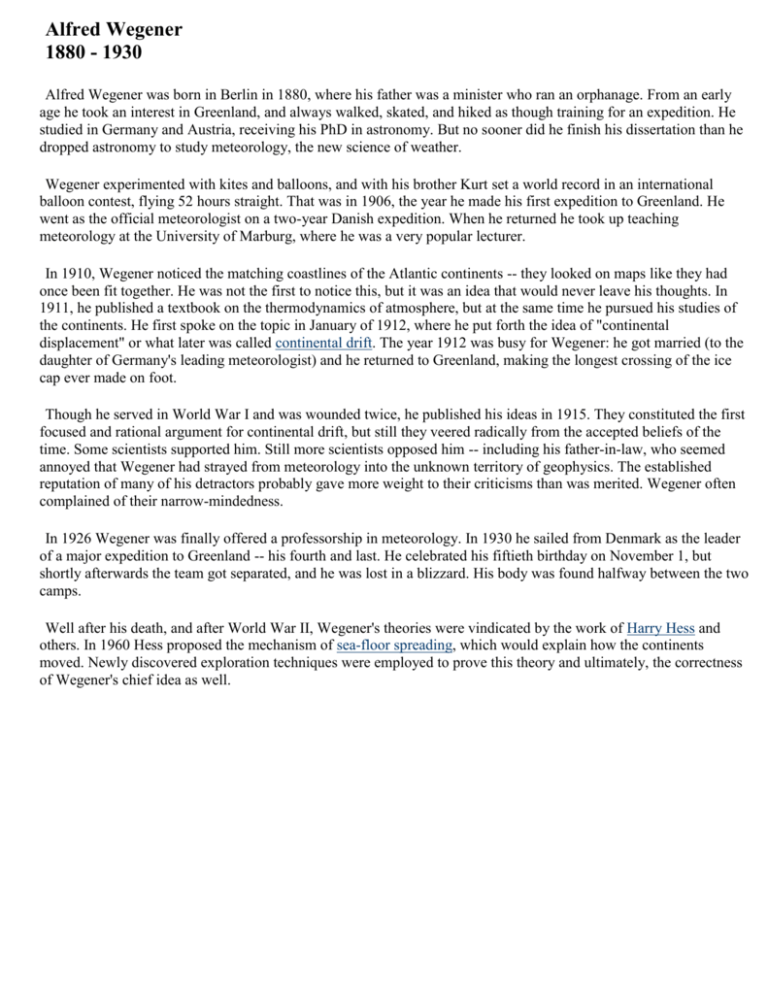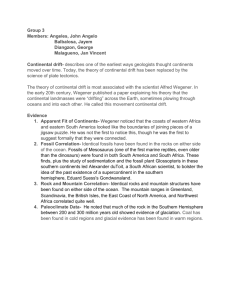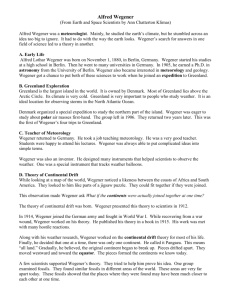Alfred Wegener 1880
advertisement

Alfred Wegener 1880 - 1930 Alfred Wegener was born in Berlin in 1880, where his father was a minister who ran an orphanage. From an early age he took an interest in Greenland, and always walked, skated, and hiked as though training for an expedition. He studied in Germany and Austria, receiving his PhD in astronomy. But no sooner did he finish his dissertation than he dropped astronomy to study meteorology, the new science of weather. Wegener experimented with kites and balloons, and with his brother Kurt set a world record in an international balloon contest, flying 52 hours straight. That was in 1906, the year he made his first expedition to Greenland. He went as the official meteorologist on a two-year Danish expedition. When he returned he took up teaching meteorology at the University of Marburg, where he was a very popular lecturer. In 1910, Wegener noticed the matching coastlines of the Atlantic continents -- they looked on maps like they had once been fit together. He was not the first to notice this, but it was an idea that would never leave his thoughts. In 1911, he published a textbook on the thermodynamics of atmosphere, but at the same time he pursued his studies of the continents. He first spoke on the topic in January of 1912, where he put forth the idea of "continental displacement" or what later was called continental drift. The year 1912 was busy for Wegener: he got married (to the daughter of Germany's leading meteorologist) and he returned to Greenland, making the longest crossing of the ice cap ever made on foot. Though he served in World War I and was wounded twice, he published his ideas in 1915. They constituted the first focused and rational argument for continental drift, but still they veered radically from the accepted beliefs of the time. Some scientists supported him. Still more scientists opposed him -- including his father-in-law, who seemed annoyed that Wegener had strayed from meteorology into the unknown territory of geophysics. The established reputation of many of his detractors probably gave more weight to their criticisms than was merited. Wegener often complained of their narrow-mindedness. In 1926 Wegener was finally offered a professorship in meteorology. In 1930 he sailed from Denmark as the leader of a major expedition to Greenland -- his fourth and last. He celebrated his fiftieth birthday on November 1, but shortly afterwards the team got separated, and he was lost in a blizzard. His body was found halfway between the two camps. Well after his death, and after World War II, Wegener's theories were vindicated by the work of Harry Hess and others. In 1960 Hess proposed the mechanism of sea-floor spreading, which would explain how the continents moved. Newly discovered exploration techniques were employed to prove this theory and ultimately, the correctness of Wegener's chief idea as well.











